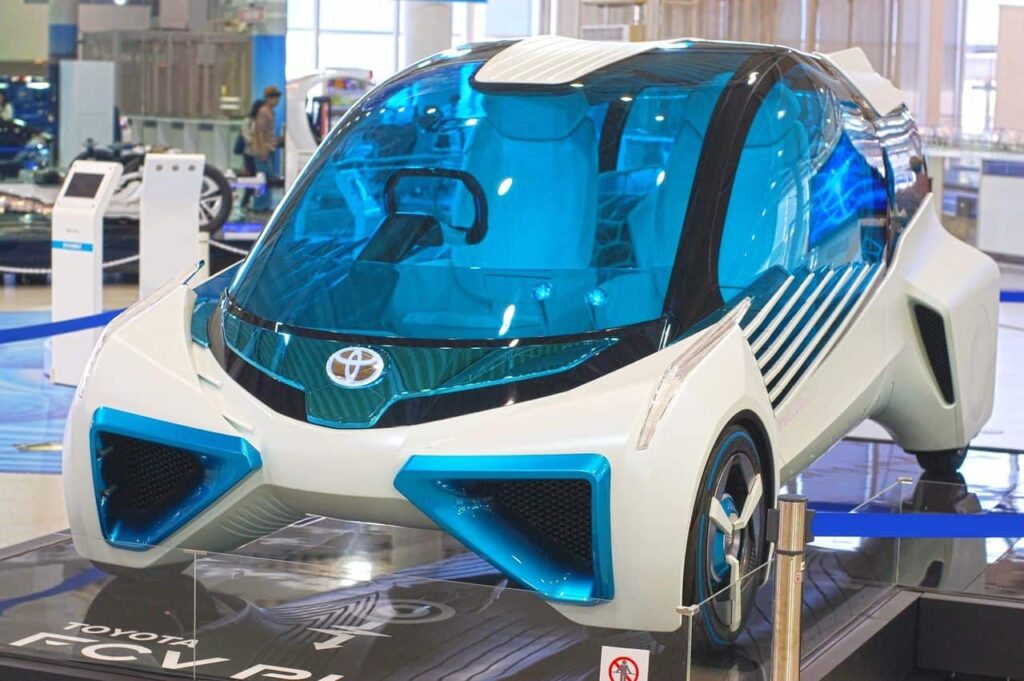15 June 2021 Concept Car
We all want to protect the planet. Unfortunately, driving a car presents a bit of a conundrum in this regard: Aren’t all cars inherently bad for the environment?
In a way, yes.
But there are still a few things you can do to reduce the damage.
Driving a new car rather than a prehistoric oldtimer seems an obvious choice. After all, new cars have higher fuel efficiency and a wealth of technologies which limit air pollution.
That seemingly trivial statement is not quite as self-evident as it may seem. In fact, experts have debated whether or not new cars are really greener for many, many years.
They still aren’t entirely sure.
In response to a reader question, ecology website Grist went to great lengths debating the topic, only to conclude: Your only safe bet is walking.
So if you intend to buy a new car to ease your conscience, you really do need to read this article. You may not save the planet in doing so. But at least, in the end, you’ll know all you need to know to make an informed decision.
No doubt: Progress in car technology has been nothing short of miraculous over the past decades. Especially when it comes to overall safety, current models are so much better than their predecessors that we probably wouldn’t ever want to hop onboard a pre-1990 automobile ever again.
Improvements in materials and construction have been the main drivers of this evolution. Car materials have become lighter, more sturdy and rust-resistent. This has also benefited fuel efficiency. Using the same design, a car leaving the factory today would easily beat a comparable car from ten years ago in every single respect.
That said, this is precisely where things get complicated. Simply put, it is very hard to compare cars from today with cars from yesteryear. And sometimes, against common sense and all expectations, the older automobiles don’t fare all that badly in those comparisons. We’ll get to that further below in this article.
More importantly, fuel efficiency and even pollution emissions aren’t the only standards by we can measure the greenness of a specific model. We need to take a broader and longer-term view.
Once you start doing that, you’ll quickly realise that progress is relative.
 Modern motors do emit less noxious substances than older ones. That’s a fact.
Modern motors do emit less noxious substances than older ones. That’s a fact.However, it’s not the end of the story.
Producing a car in itself also requires energy. In fact, it requires A LOT of energy. Writing about the poster boy of the early hybrids, Wired notes:
“Hybrids get great gas mileage but it takes 113 million BTUs of energy to make a Toyota Prius. Because there are about 113,000 BTUs of energy in a gallon of gasoline, the Prius has consumed the equivalent of 1,000 gallons of gasoline before it reaches the showroom. Think of it as a carbon debt – one you won’t pay off until the Prius has turned over 46,000 miles or so.”
What matters, therefore is not just the petrol you burn while you’re driving it. What ultimately matters is how much petrol is required for producing and driving a car during its entire lifetime.
This is what experts refer to as lifetime emissions.
If we consider lifetime emissions, a lot of deeply entrenched facts about the industry suddenly become questionable.
Petrol cars are suddenly, at least up to a certain point, more ecologically friendly than EVs.
Buying a second hand car can suddenly, from an ecological point of view, appear to be a better choice than getting a new one.
Plug-in hybrids are suddenly the worst, rather than the best of both worlds.
How is this even possible?
It all has to do with what we hinted at before: Making a car is an extremely energy-intensive process. Writes ZME Science:
“A 2004 analysis by Toyota found that as much as 28% of a car’s carbon dioxide emissions are generated during the manufacturing stage. In 2010, another analysis found that up to half of a car’s emissions come from its production, while other analyses propose lower figures.”
Those numbers may be accurate or slightly too high. Either way, it’s pretty obvious that you can not pick a car for its greenness without taking into account the fuel burned for its production.
Think about it: A used car already exists. Yes, it may have been less efficient to produce and it will almost certainly be less efficient in terms of fuel consumption in the future (we’ll go into why this isn’t entirely certain a bit later). But since it has already been made, you no longer need to take the energy consumption for the production process into consideration.
This gives used cars an inherent edge over almost every single modern vehicle out there.
In fact, depending on how many miles you drive and also depending on your driving style, that new car may never catch up!
 Electric Vehicles are an even more complex topic.
Electric Vehicles are an even more complex topic.Electric vehicles are the future of driving. And that future is coming sooner than you might think. In the UK, petrol cars could become obsolete in just and a half decades.
That’s an incredible sign of just how far the industry has come on its way towards supporting rather than blocking efforts to curb climate change. (although they did initially try their best to prevent the plans of a quick phase out)
In a remarkable and insightful analysis, Australian website Gumtree posted an intriguing fact:
“50 of our most popular used vehicles outperformed Tesla when it comes to being environmentally friendly, according to the Australian Government’s Green Vehicle Guide (4 of our 20 most popular models were not included on the website).”
That in itself should cause a shock: You can buy the most expensive and reputable EV on the market and still end up worse off than with a regular petrol engine!
Although Gumtree doesn’t seem to directly explain what causes this, it would appear that the rub lies in the battery. It contributes the largest percentage to the energy expenditure of an EV by far. And, as Gumtree has found out by talking to experts, since batteries are getting increasingly larger to meet demand for higher mileages, their ecological balance is no longer clear:
“According to David Abraham, author of The Elements of Power, “We’re shifting pollution, and in the process we’re hoping that it doesn’t have the environmental impact.””
Batteries seem like the cleanest thing in the world. But in terms of their energy balance, they are certainly not particularly green yet.
The thing is, to produce batteries doesn’t only take a lot of energy. It also requires mining operations which are extremely damaging to the environment.
Writes Wired in a detailed report:
“The lithium in the batteries is super light and conductive—that’s how you get a lot of energy without adding a lot of weight. Other, rare metals are sprinkled throughout the car (…). But those rare metals come from somewhere—often, from environmentally destructive mines. (…) (…) Rare metals only exist in tiny quantities and inconvenient places—so you have to move a lot of earth to get just a little bit. In the Jiangxi rare earth mine in China, Abraham writes, (…) rare earths amounted to 0.2 percent of what gets pulled out of the ground. The other 99.8 percent—now contaminated with toxic chemicals—is dumped back into the environment.”
Electric vehicles are undoubtedly still the future. But in the present, they still create as many new problems as they create solutions.
 Are hybrids ecologically friendly?
Are hybrids ecologically friendly?The answer to the question of whether or not hybrids are truly ecologically friendly remains unclear.
Before there were electric vehicles, there were plug-in hybrids. These cars seemed like a great bridge from regular petrol engines towards the more sustainable electric cars.
A hybrid car combines a petrol motor with a battery. As a default, these vehicles will start running on their battery first. The petrol engine will only come into effect the moment the battery runs empty. If you’re merely driving short distances – for example, because you live in the city – you may not have to resort to the petrol option at all. You simply recharge the battery once you get back home in the evening and you’re good to go again in the morning.
For many ecologically minded drivers in the UK and around the world, hybrids were an attractive introduction to the future of driving.
However, more and more, the major disadvantages of hybrids are coming to the fore.
Hybrids, as the name implies, have two power sources – an internal combustion engine and a battery. This adds weight to the car. You could take an EV with a bigger, longer-lasting battery and save weight. You could also go for a greener ICE with a better ecological profile and possibly achieve a better footprint.
Hybrids need to be serviced like regular, old school petrol cars. You will need to replace parts just like you would with a petrol car. Their production involves all the bad processes required to make an ICE as well as the bad processes required to mine the light metals needed for an electric car.
As a transitional concept, hybrids certainly served their purpose. They are still pretty decent in terms of their ecologic footprint. (Of course, this this comes with a caveat. You need to keep hybrids properly charged. Only in doing so will you ensure that you won’t exhaust the battery and won’t have to switch to petrol mode). The Prius alone convinced the otherwise not particularly green-minded USA that the switch to new car models was possible.
It just seems as though this is now an idea which has run its course.
 New cars are better. But they’re also getting bigger.
New cars are better. But they’re also getting bigger.One reason why the entire energy-debate has become so confusing is that it can sometimes seem as though modern day consumers are hell bent on making sure their fuel consumption does not go down.
When batteries were getting better, they demanded bigger ones which instantly offset the benefit. And when engines were becoming more efficient, they opted for bigger, bulkier, heavier cars which, again, all but entirely destroyed the gains made by novel technologies.
Ever since Ford introduced its Model T, cars have become less and less efficient for almost seventy years. Fuel consumption for an average car in the 70s was WORSE than it was for the Model T, a far less advanced car in just about every other way! It was only in the 70s that the big brands first started to seriously contemplate fuel consumption as a sales point.
Once they had reached the absolute minimum of what was demanded from them, they again stalled. There were no further improvements for fifteen years! Finally they were forced, this time both by regulatory changes and public demand, to step up their game.
 Older cars are much better than you’d expect.
Older cars are much better than you’d expect.Today’s cars are very likely the most efficient they have ever been. But still, the craze for SUVs and the ongoing trend for bigger sized vehicles, puts a brake on that progress. As a result, older and smaller cars may outperform newer models in the fuel efficiency department – as absurd as that may sound.
This points to something which we need to stress, especially since we’re working with used cars every single day: For the past twenty years, buying a second hand model has never been a safer choice. Used automobiles, even from as far back as the mid-1990s, can be pretty great in every single way. Yes, they may look slightly outdated. And they offer decidedly less space than their current counterparts. But overall, they offer more than decent driving characteristics, acceptable comfort and safety.
As has been pointed out by experts, older cars may deteriorate in some departments. But their petrol consumption usually stays pretty much the same.
There are plenty of potential sources of problems with these cars. Finding suitable replacement parts for repairs , for example, is an obvious one. But the direct comparison is a lot more flattering for them than you might think.
Another thing you need to be aware of is that fuel efficiency as a factor of a car’s greenness is not quite as easy to measure as you might expect. This makes it hard to compare the performance of a modern car with that of its predecessors.
Why is it so hard to compare them?
The simple reason is that officials worldwide recently changed the rules for measuring fuel consumption. At the same time that they introduced the Euro 6 standard, they demanded manufacturers base their fuel efficiency data on a new test.
This new test is called WLTP (Worldwide Harmonised Light Vehicle Test Procedure). The old test was called NEDC (New European Driving Cycle). Although the last version of the NEDC only ran between 1997 and 2005, the basic approach of the NEDC was pretty much the standard ever since emission tests were first introduced.

The simple difference between the NEDC and WLTP is that the current emission test takes realistic driving circumstances into consideration, whereas the previous version was, in a way, a “laboratory test”.
When you’re driving, you’re constantly faced with imperfections:
The WLTP takes these realistic situations into consideration and its emission numbers are therefore a lot closer to what you will actually consume.
As BuyaCar note:
“This should be much more representative of real roads and traffic, and so you should be able to get closer to this figure with normal driving. All new cars registered from September 2019 onwards should have fuel economy and emissions figures calculated using the more realistic WLTP test. Bearing this in mind a car that achieves 50mpg on the newer WLTP test is likely to be more economical in everyday driving than one that has a 50mpg figure recorded on the old NEDC test.”
This makes a direct comparison harder. Speaking generally, however, we can definitely say that current numbers are better predictors of consumption. Older numbers are often inflated.
So far in this article, we’ve merely vaguely spoken about ’emissions’. That is admittedly a pretty broad term. Many routinely assume that the only emissions we need to be concerned with are CO2.
This is, however, certainly not correct. There are quite a few other toxic or environmentally unfriendly substances which add to the ecologic burden of petrol.

You can generally assume that modern cars are better at filtering out a wider range of toxic substances than older ones. This does give them an advantage which extends beyond the mere reduction of greenhouse gases.
So maybe petrol cars are becoming a thing of the past. For the moment, however, they still constitute the largest section of cars on the roads. With that in mind, every measure we can take to improve their efficiency is welcome.
Here are a few of the technologies that can make a difference:
Petrol cars will never be good for the environment. But at least we can make them as good as they can possibly be.
15 June 2021 Concept Car